Central Sugar Mills
The central sugar mill concept began in Puerto Rico with the establishment of Central San Vicente in 1873. Many central sugar mills were subsequently established none of which are in operation today. The following pages are dedicated to document the sugar mills of which remains are still found, some of which the only remain is a chimney or a related structure.
In addition to all the sugar mills that were buit since 1873, some never made it pass their planning stage. In 1906 the Porto Rico American Tobacco Co. had plans to build a central sugar mill but decided to increase the size of its tobacco plantations instead. In the early part of the 1910s the Santiago brothers planned a central sugar mill in Coamo that never happened. Manuel Gonzalez was one of the largest colonos of Central Aguirre and also in the early 1910s planned to build Central Covadonga in Salinas but never did. Also never seeing the light of day were Cetral Ciénaga between Hatillo and Camuy and Cidra Sugar Co. in Cidra. Sosthenes Behn plans for the Compañia Azucarera de Caguas and Rio Grande Centrale near Canóvanas never materialized.
There were many sugar mills that have been totally demolished and for which no remains at all are known. The only exception is Central Playa Grande in Vieques for which there are remains left but we have yet to photograph.
Those sugar mills for which no remains are known are listed below. The information for the ones with names highlighted in gray was obtained from Volumes 1 & 2 of the 1902 book by José Ferreras Pagan Biografía de las Riquezas de Puerto Rico.
- Central Alianza – Camuy (1910-1922). Was organized in 1910 with a capital of $600,000. Its principal shareholders were Spanish immigrant from Sóller Andrés Oliver Roses the son of Catalina Roses Bisbal whose family owned Hacienda Santa Barbara, Manuel Ledesma Figueroa (1869-1923), Spanish immigrant from Mallorca Francisco Perelló Cerdá (1874-1925), Sebastian Figueroa Colón (1850-1932), Spanish immigtant from Blanes Agustin Plá Puigmoler (1868- ) and another investor with last name Igartúa. Its machinery was that from the old Central Oriente which had been acquired by Central Cambalache for its lands.
- Central Bello Sitio – Rio Piedras (1873-1891) Was owned by Geronimo Landrau Malaret (1819-1904). In May 1891, with the end of the crop season approaching, the first recorded worker’s strike in Puerto Rico took place at Central Bello Sitio where laborers demanded higher wages. The strike resulted in the closure of operations. Subsequently, its machinery was sold to Adolfo Veve Feraud and installed at his Hacienda Monserrate in Rio Grande ca. 1900 which had been closed and according to Ferreras Pagan in ruins.
- Central Buena Vista – Carolina (1882-1911) Was established at Barrio Hoyo Mulas of Carolina by Ignacio Arzuaga who installed a steam driven mill. In 1882 equipment from the defunct Hacienda Monserrate in Rio Grande was installed elevating it to a central sugar mill. It was later owned by the firm Sobrinos de Ezquiaga, established in San Juan in 1821 by Spaniard Jose Ignacio Ezquiaga (1775-1845) a native of Guipuzcoa in the Basque Country and a relative of Arzuaga. In 1908 it was acquired mainly for its lands by the Loiza Sugar Co. who had recently acquired Central Canovanas. For the 1912 grinding season, its mill was acquired by Cia. Azucarera de la Carolina whose major shareholder was also Sobrinos de Ezquiaga and installed at its Central Progreso.
- Central El Buey – Camuy
- Central Camuy – Camuy (1912-1913) The publication The Louisiana Planter and Sugar Manufacturer in its edition of July 30, 1910 reports that: “The Camuy Sugar Co. lately established and now erecting its central, expects to be able to put 30,000 sacks of sugar on the market for the 1911-1912 campaign, first grinding being scheduled for Decmber 1911.” The edition of November 4, 1911 states that it is a complete new factory referring to its all brand new equipment and machinery. The edition of June 8, 1912 includes an article where they presented their readers with “this new Central sugar factory in PR”. It states in the article it is the most modern factory on the island and this the first year of its grinding. Its Board of Directors consisted of Eduardo Georgetti, President; José Machado, Vice President; José Ruiz Soler, Secretary and Pedro G. Amador,Treasurer. However, its shareholders were mainly members of the Amador family. In 1913, it closed down, was dismantled and sold for $150,000 to a group in Venezuela headed by Gen. Ingnacio Andrade former President of that country. The Louisiana Planter ad Sugar Manufacturer in its edition of 12/6/1913 reported that Luis Soler, in representation of Central Camuy’s interests, closed on the sale due to financial difficulties. In its edition of 12/1/1917 it reports that the recently erected Central La Ceiba in Maracaibo was the transplant of Central Camuy in Puerto Rico. Central Rio Llano was later erected on the site of Central Camuy.
- Central Constancia – Ponce (1910-1954) Constancia evolved from an agricultural partnership established in 1881 by Spanish immigrant Félix Saurí Vivas (1852-1915) and Asisclo Subirá Ramirez de Arellano (1849-1914) to operate the Hacienda Estrella. The sugar mill, known at inception as Central Estrella, was owned by Saurí & Subirá & Co., a corporation formed by the heirs of Felix and Asisclo, one of whom was Rafael Sauri Tristani (1881-1952) son of Féliz Surí Vivas. It owned most of the land used for growing sugarcane making it practically independent of cane purchased from colonos. The November 30, 1917 edition of the The Louisiana Planter and Sugar Manufacturerstates: “The advent of the first mill making white sugar direct in Porto Rico marks a new era in the industry in the island. It was put in at Central Constancia at Ponce. Sauri & Subira, the owners, have been making sugar for direct local consumption for years and have been putting out a sugar somewhat whiter and purer than the ordinary raws, but now this white sugar made so by sulfur, lime and filtration processes marks a great era of advancement. The installation cost $250,000 and the sugar cane capacity of the plant will be 250 tons daily.” The machinery was manufactured by Krajewski Pesant Corp., Inc. who had built the manufacturing plants at Central Vannina and Central Lafayette.
- Central Corsica – Rincón (1885-1920) Was established in 1885 as the 250 acre Hacienda Rafucci when Domingo Rafucci Padovani (1848-1906), a Corsican immigrant that arrived in Puerto Rico in 1868 to work at Hacienda Tres Hermanos in Añasco of his uncles Carlos, Juan and Felix Padovani bought the old hacienda Theopolis. In 1888 Domingo returned to Corsica leaving his son Alfredo Rafucci Bayrón (1877-1943) as administrator. By 1912 Alfredo had developed the hacienda into a central sugar factory with approximately 1,164 company controlled acres planted with sugarcane that included those of the old Hacienda Tres Hermanos. In 1913 Central Corsica secured a $100,000 loan from the West India Sugar Financing Corporation, that year Ramón Aboy Benitez, also owner of Central Arcadia in Vieques, was its President, Jaime Sifre of Carmen Centrale was its Administrator and George Dana Graves, in representation of the West India Sugar Financing Corporation was its Treasurer. Two sons-in-law of Domingo worked at Corsica, César Emilio Dechoudens whose uncle owned the nearby Hacienda Eugenia was the sugarman and Corsican immigrant Esteban Steffani, the father of Luis Steffani Rafucci was the accountant. Central Corsica was located on the right hand side of the railroad tracks from Aguadilla to Mayagüez at km 22 about 100 m from the sea shore in a valley by “cerro” San Francisco about 4 km south of Rincón. It suffered extensive damage in the 1918 earthquaqe that hit the western part of Pueto Rico. Supposedly the old manor house, brick ovens and two water tanks still remain standing.
- Central Defensa – Caguas (1920-1939) See Hacienda San José
- Central El Ejemplo – Humacao (1898-1962) Was located in Barrio Mariana about 6 miles from the Port of Humacao. El Ejemplo’s beginning date to 1896 when Antonio Roig Torrellas (1851-1933) acquired 12 cuerdas and a steam mill segregated from the 1,878 cuerda Hacienda Providencia owned by Rodulfo Leoncio Perez. Roig then installed machinery acquired from the Pioneer Iron Works in NY elevating it to a central sugar mill in 1898. Financing for the purchase was provided by Fritze, Lundt & Co. for whom Roig had worked in Mayagüez where his father was established after immigrating from Catalonia, Spain. In its beginning, Central El Ejemplo started without land of its own processing sugar cane grown by colonos, its main colono being Perez himself who agreed to grow 400 acres of sugarcane to be processed at El Ejemplo. Perez also agreed to allow railroad tracks to be laid on his land for the use of the sugar mill. The Cia. Azucarera El Ejemplo was incorporated July 17, 1909 by which time Roig owned approximately 12,500 acres and leased some 5,000 additional acres to grow sugarcane for his mill. By 1935 almost all sugar cane it processed was grown on lands of the Roig family. Its machinery was sold in 1965 to the South Florida Sugar Co. Antonio Roig Torrellas was also instrumental in the development of Central Juncos.
- Central El Ingenio – Yabucoa (1891-1903) Was established in Barrio Aguacate by José Anglada. In 1898 it was sold to Manuel Argüeso Flores and his wife Ernestina Frias Noya. It had 1,200 acres of its own of which 600 were planted with sugarcane and processed sugarcane from several colonos in the area. In 1903 Mullenhoff & Korber instituted foreclosure proceeding for unpaid debt and crop financing contracts totaling some $88,000 which legal case bacame very bitter, hostile and complicated. On December 9, 1904 title to Central El Ingenio and its lands was awarded at public auction to Mullenhoff & Korber. On July 6, 1905 title to the lands except for a tract retained by Mullenhoff & Korber in satisfaction of their lien, was reverted back to Agüeso’s brother in law Atty. Salvador Fulladosa Mir. The transfer to Fulladosa Mir was made according to an agreement between Mullenhoff & Korber and Argüeso, calling for a cash payment of $13,250 by Mullenhoff & Korber to Argüeso and intended to erase a $40,000 second mortgage held by Juan Bertran Casañas and other junior lien holders. The case Juan Bertran y Casañas Et Al v Mullenhoff & Korber Et Al decided by the Supreme Court of Puerto Rico in 1908 clearly details the events surrounding the foreclosure and subsequent title transfers.
- Central Esperanza – Arecibo (1898- ) Not much information is available on this sugar mill except that it was at one time owned by Bernardo Huicy who in 1902 was administrator of Central Las Claras.
- Central Fortuna – Rio Grande (1892-1909) Its original owners when it was just a blood driven mill were Avelino (1828-1885) and Félix Rexach Porrata Doria who sold the property to Eugenio Benitez Guzmán ca. 1867. Benitez Guzmán sold it to Medesta Román who in turn sold it to Alfredo Cristy Vanell (1835-1932) in 1892. Under Benitez Guzmán ownership, a steam driven mill was installed but shortly thereafter the sugar factory was closed and its equipment sold to and installed at Hacienda Carmelita. When Cristy acquired the property he installed a mill, boilers, vacuum pans, centrifugals and other equipment from Hacienda Santísima Trinidad of his property in Mayagüez which had shut down due to an epidemic that affected sugarcane in the area. In 1899 Manuel Gonzalez leased and operated the sugar factory.
- Central Fortuna – Yauco (1906-1925)
- Central Guamani – Guayama (1930-1963) It owners were Sucn. J. Gonzalez, G. Gonzalez and Genaro Cautiño Insua. It was located at Barrio Jobos of Guayama in the general area where there is a Cemex plant today, south of the PR-3 and PR-713 intersection. Planning of this sugar mill began in 1924 and its contruction finished in 1929 in time for the 1930 milling season. Reportedly part of the machinery used was from Central Columbia which ceased operations in 1928. After its closure its machinery was sold to Central Aidsisa in the Philipines.
- Central Juanita – Bayamón (1895-1963) Its origin dates back to 1890 when Spanish immigrant from Palma de Mallorca Antonio Monroig Oliver established a factory to produce molasses and muscovado sugar. In 1895 the factory building was expanded and new vacuum pans, centrifugals and boilers were installed elevating it to a central sugar mill. It had a modern 750 KW Westinghouse turbine to drive all the machinery except the mill which was steam driven. After Antonio’s death on April 20, 1903, it was owned by the firm Antonio Monroig e Hijos consisting of his wife Josefa Obrador Vilá and their children Juan, Antonio, Valentin and Maria Monroig Obrador. In 1911 it was acquired by Central Juanita, Inc. whose main shareholder was the Fonalleda family. In 1937 the main shareholders of Central Juanita, Inc. were Jaime and Guillermo Fonalledas, Rafael Arrieta and Dr. José A. Lopez Antongiorgi. It was located west of the road to Cataño and east of the Bayamon River 1 km more or less from the train station. The Bayamón River crossed its 800 acres from South to North which river was used to transport sugarcane from the fields to a dock near the factory.
- Central Juliana aka Central Herminia – Villalba (1919-1948) The Louisian Planter and Sugar Manufacturer Volume 44 No. 23 of June 4, 1910 states; “Latest advices proclaim that the incorporation of the new Central of Villalba has been effected, the organizers and the principal shareholders being such well known sugarmen as the Sres. Verjas (sic), Serrallés, Astol, Oppenheimer, Claussells, Marvin and Fabián.” It appears this venture never materialized as it is widely accepted that Walter McK Jones (1883-1944), a native of Boston and founder and first Mayor of the town of Villalba, established Central Juliana in 1919. In 1940 the sugar mill was acquired by the Semidey family of Coamo who changed the name to Herminia. Its last known owner was Herminia Colón vda. Semidey, the widow of Francisco Semidey Semidey of Coamo.
- Central Las Claras – Arecibo (1877-1906) Was established by Fernando Fernandez Umpierre (1839-1898) Marqués de las Claras, a sugar baron in Arecibo who built his house known then as Palacio del Marqués de las Claras. This property later came to be the Casino de Arecibo. His daughter Manuela Fernandez Muñoz (1864-1902) Marquesa de las Claras, married Manuel Elzaburu Vizcarrondo (1841-1892) and in 1898 then a widow, married in Madrid her brother-in-law Francisco Elzaburru Vizcarrondo. The Marquesa de las Claras acquired this property from Francisco Serrat ca. 1877 when it became a Central Sugar Mill. In 1902 its Manager was Bernardo Huicy. It was located near the Rio Grande de Arecibo on the old road to San Juan south of the railroad tracks and near the Cambalache train station. In 1906 Central Las Claras was acquired by Central Cambalache.
- Central Laura – Yabucoa (1884-1901) Was owned by the firm Cintrón Hnos. comprised of Jose Facundo Cintrón Cintrón (1846-1901), Zoilo Cintrón Cintrón, Carmen Margarita Cintrón Cintrón who was married to Mariano Martorell Casalduc and Eulalia Cintrón Cintrón who was married to Aurelio Dapena Moreno the Administrator of the firm. Central Laura consisted of 491 cuerdas property of Cintrón Hnos., another adjacent 440 cuerdas known as Cercado Diamante and Dos Rios plus another 231 cuerdas known as Palmarejo and Margarita. It also had a 3 km railroad line. In 1895 Cintrón Hnos. recived a 90,000 Mexican Pesos loan from the Banco Territorial y Agricola. On May 23, 1900 due to unpaid installments on this loan and subsequent advances, Cintrón Hnos. represented by its administrator Aurelio Dapena Moreno, handed over the administration of Laura to the bank who had its sugarcane processed at Central Roig. The firm Cintron Hnos. was dissolved in 1901 and on September 30, 1902 Banco Territorial y Agricola began foreclosure proceeding on the mortgage received to secure the above loans, acquiring title to the sugar mill and 491 cuerdas of land at a court ordered auction sale on March 26, 1903. This court sale was contested by the surviving heirs of Cintron Hnos. and again was awarded to the Banco Territorial y Agricola on May 19, 1906. The bank subsequently sold the property to Manuel Dueño for $100,000 who sold it to Yabucoa Sugar Co. for $213,109.51 in 1912.
- Central Luisa – Maunabo (1874-1883) Hacienda Luisa was elevated to a sugar mill in 1874 when owned by Luisa Pillot who acquired it when an ingenio from Alberto I. Bentegeat y Brisart. Luisa was married to Louis François de Boyrie (1843- ) the son of Eugene de Boyrie and nephew of Marie Felicie de Boyrie (1806-1881) who married Benjamin Clauzel (1794-1866). He was the first cousin once removed of Emma Lepelleux the wife of Juan Francisco Vergés and second cousin of Eugene Marcelin Vergés Lepelloux. The Clauzell and Vergés families were all related to Central Columbia in Maunabo. By 1883 the ingenio had ceased operations when Cail & Co. foreclosed for unpaid debt on machinery supplied and financed for approximately $64,000. The machinery was removed and sold to Eugene Marcelín Vergés Lepelloux later of Central Columbia. A foreclosure suit was decided in 1886 in favor on Bentegeat for an unpaid mortgage in the amount of $6,600. On November 4, 1886 however, the Court ordered the sale in Public Auction of assets valued at $9,988 including Hacienda Oriente, also known as Luisa, in Barrio Talante of Maunabo consisting of 190 cuerdas and several structures in poor condition including a deteriorated sugar processing plant and two chimneys. In 1883, after his failed venture, Louis Francois de Boyrie left for the Dominican Republic where he was involved in the management of Ingenio La Francia that was established that same year.
- Central Maria – Rio Grande (1892-1901) Was established ca. 1866 by Spanish immigrant Antonio Zechini ( -1891) as a hacienda with an oxen driven mill. A year after his death, it passed on to his estate represented by Antonio Zechini Veve (1862- ) who installed a steam driven mill and a vacuum pan elevating it to a central sugar mill. Zechini Veve was the son of Eulalia Clestina Veve Feraud (1830-1900), sister of Miguel Antonio Veve Feraud owner of Ingenio Concepcion in Ceiba and was married to Josefa Benitez Calzada (1870-1936) daughter of José Eugenio Benitez Guzmán owner of Central Playa Grande in Vieques. Hacienda Maria consisted of 1,200 acres of its own of which 400 are used to grow sugarcane. It was located about ½ km north of town, the Espiritu Santo River crossed its lands. After its closure its sugarcane was processed at Central Canóvanas.
- Central Pagán – Añasco (1883-1918). It was located about five minutes southeast of the town of Añasco near the train station, its land comprised the old haciendas Ursula, Librada, Cipriana and Elisa. The Rio Daguey meandered through its lands. The 1984 document titled Añasco: Notas para su Historia written by Dr. Carlos Gaztambide Arrillaga states that Juan Bianchi was the original owner of Pagán while a hacienda. Bianchi was born in Añasco and was married to Luisa Bracetti the sister of Mariana Bracetti – Brazo de Oro. After the death of Juan Bianchi in 1827, Luisa married Juan Pagán and after his death in 1873, the hacienda was inherited by her son Juan Bianchi Bracetti (1829-1902) also known as Juan Bianchi Pagán in honor of his stepfather Juan Pagán who raised him since age two. It was later owned by Juan Bianchi Rosafá the son of Juan Bianchi Pagán and Rosario Rasafá and subsequently leased in 1910 to La Guanica Centrale.
- Central Pasto Viejo – Humacao (1907-1958). Was located on the banks of the Antón Ruiz River. Although its first milling season appears to be 1907, it was first organized under the name Humacao Sugar Co. by Cuban born William L. Bass also owner of Ingenio Consuelo in San Pedro de Macoris in the Dominican Republic. On May 16, 1907 the Puerto Rico Sugar Co. was incorporated to acquire Pasto Viejo from the Humacao Sugar Co., being its first Board of Directors comprised of Eduardo Georgetti, President; Luis Rubert, Vicepresident; Abelardo de la Haba, Secretary; José Ruiz Sóler, Assistant Secretary; Gerónimo Vallecillo, Treasurer; Rafael Balseiro, Assistant Treasurer; Jose Toro Rios and Carlos Armstrong Toro Directors. Other notable shareholders were Juan Carlos McCormick, Rafael Fabián, Luis Toro Pasarell and Ramon Aboy Benitez, US investors H. C. Guiler, George T. Parker and Moses A. Walker and German capitalist Waldemar Hepp. In early 1910 because of financial difficulties, the assets of the Puerto Rico Sugar Co. were acquired for $925,000 by Borinquen Sugar Co. whose majority shareholders were Rafael Fabián and Juan Carlos McCormick. Borinquen Sugar Co. struggled every year of its existence and in 1912 Hernand Behn was appointed receiver by the Court. In 1914 while under receivership, a group known as the Federal Syndicate of Humacao rented and operated the sugar mill for the 1915 grinding season which was Pasto Viejo’s first successful season. In June 1915 members of the syndicate organized Central Pasto Viejo, Inc. and purchased at public auction the assets of Borinquen Sugar Co. The person behind the syndicate’s success was Engineer Ignacio Peña who had 7 years experience in the US and had worked at Central Constancia in Toa Baja which was run by his uncle Francisco Arrieta. Pasto Viejo was one of the five sugar mills acquired in 1926 by the United Puerto Rican Sugar Co., later known as Eastern Sugar Associates after United filed for bankruptcy in 1933 and was lastly owned by the Fajardo Sugar Co.
- Central Porvenir – Adjuntas (1908-1925)
- Central Progreso aka Central Victoria – Carolina (1887-1958) Central Progreso was located in what was the 620 acre Hacienda Aurora, owned by José Saldaña Pimentel ( -1867), later by his son Manuel Saldaña Peña (1839-1888). Haciend Aurora was the subject of a painting by Francisco Oller, photo of which is included in the gallery below. The sugar mill was built in 1887 on 15 acres sold by Manuel Saldaña to Lamb & Co., a British firm with offices in St Thomas. Crosas & Finlay managed it until 1888 when The Puerto Rico Sugar Factory Ltd., whose main shareholders were Lorenzo D. Armstrong of the NY commercial banking firm L. W. & P. Armstrong and British citizen Frderick Barnes, took control of Progreso. By 1900 it was owned by Mayrn, Armstrong and Finlay Bros. & Waymouth and its administrator was Enrique Van Rhyn. In 1910 the Compañia Azucarera de la Carolina owned by Sobrinos de Ezquiaga bought the Central from Finlay Bros. The new owners added lighting and built new offices with electricity and in 1912 installed the mill, centrifugals, crystallizers and a large Stirling boiler from the recently closed Central Buena Vista. In September 1919, brothers Buenaventura and Luis Rubert Catalá, J. D. Riera, Eduardo Georgetti, Enrique J. Gonzalez and Abelardo de la Haba formed a five year agricultural and industrial partnership under the name Central Victoria, Ltd. A transfer was made to the partnership of the sugar factory Central Progreso and of other properties of the Compañia Azucarera de la Carolina. The partnership commenced operations under the presidency of Gonzalez. Rafael Fabián Fabián acquired interest in Victoria by purchasing part of the interest of J. D. Riera from his estate. In 1921 the court appointed a receiver due to dissent between the partners, which order was set aside by petition of E. J. Gonzalez. The chimney, was its last remaining structure, was imploded in 2011.
- Central Reparada – Ponce (1883-1900). This sugar mill was located in the general area where the Pontificia Universidad Catolica is today. At one time there was a “Barrio” in Ponce called Reparada which more or less comprised the area south of the railroad tracks (today Calle Ferrocarril), west of the Rio Portugués old course, north of the Bypass (PR-2) and east of PR-2R (where Paquito Montaner Stadium is). It had water rights to draw water from the Portugués River and the Canas River which ran between Hacienda La Matilde and Reparada. It was originally owned by Ramón Cortada Quintana (1833-1905) and was acquired in 1883 by José Gallart Forgas (1838-1898) and upon his death owned by the Sucn. Gallart. It was reportedly at one time also by Mario Mercado Montalvo, owner of Central Rufina. It appears the name Reparada was given by Gallart in honor of his mother Reparada Forgas Ballo. It had 1,100 acres of its own land of which 800 were used to grow sugarcane. In his essay The Plantations of Southern Puerto Rico 1880-1910, Andrés Ramos Mattei states that Restaurada was the consolidation of Hacienda Quemado and the 187 cuerdas Hacienda Catalana.
- Central Restaurada – Ponce (1888-1903) Hacienda Restaurada was one of the first haciendas in the Ponce area dating back to the 1700s. It was located in Barrio Vayas and was originally owned by the Ortiz Matos family of Ponce who sold it to Spanish mmigrant from Catalonia José Pica ( -1831) in 1825. Upon Pica’s death, the hacienda was inherited by his dauther Josefa Pica who married also Catalonian Luis Font who managed the hacienda. Despite having only 65 cuerdas, in 1845 Font increased its sugar production making it a very efficient and succesful operation. Font sold the estate ca. 1875 to Spanish immigrant from Vinaroz, Valencian Community, Miguel Arribas Escribano (1834-1897) and upon his death was inherited by his daughter Hortensia Arribas Villoch (1869- ) and her Barcelona born husband and attorney Desiderio Canals Pujadas. From documentation reviewed, we understand Desiderio and Hortensia lived in Barcelona at the time. That being the case, we beleive that upon its closure, Central Restaurada was dismantled and its machinery sold to be installed at Central Cambalache.
- Central Rochelaise – Mayaguez (1908-1957). Its origin dates back to 1846 when French immigrant Juan Forestier acquired 275 cuerdas and named the Hacienda Rochelaise in memory of his birthplace in France, La Rochelle. Begining in 1873 a series of loans were taken from Latimer & Cia. which resulted in the foreclosure in 1878 by its major creditor the NY Merchant firm of D. De Castro & Cia., Borda & Cia. and Dr. Carlos Grivot and his wife Carolina Kobly. In 1883 D. De Castro & Cia. sold its ownership interest to Luisa Kluglist, the wife of Wenceslao Borda Rueda in exchange for shares in the Canovanas Sugar Co. Ltd. in a transaction where De Castro & Cia. was to satisfy all debt owing to Grivot & Kobly and other creditors involved in the liquidation of Latimer & Cia. During the economic crisis at the end of the 19th Century, Hacienda Rochelaise was reduced to pasture land. Central Rochelaise was established where the old hacienda was by David D. Wilson who was also related to Central Igualdad and Central Oriente and Mayagüez born and Paris educated Oscar F. Bravo González (1882-1964) and his wife Rudecinda Monagas Bianchi the daughter of Estela Bianchi Rosafá whose family also had ownership interests in Central Pagán in Añaco and Central Coloso in Aguadilla. Bravo first worked in NY and upon his return to Puerto Rico was employed by Schultze & Co., a German commercial merchant house established in Mayagüez. In 1908 ownership was transferred to the Mayagüez Sugar Co. whose main shareholders were Bravo, David & Robert Wilson, Chase Ulman and his brother-in-law and Ponce born José Miguel Morales Alvarado who was married to Sara Bravo Gonzalez. After Oscar F. Bravo Gonzalez retired in 1940, his son Eng. Jose Oscar Bravo Monagas was at the helm. After its closure in 1957, its sugarcane was processed at Central Igualdad and its machinery was sold as scrap metal in Mexico.
- Central San Cristobal – Naguabo (1905-1913) Hacienda San Cristobal was established ca. 1855 by Spanish Immigrant from Catalonia Tito Patxot with an oxen driven mill. Spanish immigrant Alejandro Viader Soler (1834-1901) acquired the property ca. 1875 and updated it with a steam mill in 1899 and operated it until his death. Since his wife Maria Hernandez and two daughters Josefa (1876-1994) and Alejandrina Viader Hernandez (1873-1997) had preceded Alejandro, upon his death Hacienda San Cristobal was inherited by his son Igancio (1880-1909) and daughter Dolores Viader Hernandez (1875-1960). The Louisiana Planter and Sugar Manufacturer Volume 21 No. 25 of December 17,1898 reports that: “A Philadelphia syndicate has acquired a large tract of land in the District of Naguabo, on the east coast, and are about to commence planting and the erection of buildings, etc.” San Cristobal was the first US investment planned after the 1898 occupation, however, its establishment took some time allowing Central Aguirre to be the first US investor owned Central Sugar Mill established in Puerto Rico after the US occupation. According to José Ferreras Pagán in his 1902 book Biografía de las Riquezas de Puerto Rico, San Cristobal was still a hacienda owned by Ignacio and Dolores Viader Hernandez, it was under the ownership of Igancio and Dolores that San Cristobal was upgraded to a Central sugar mill in 1905. In 1910 after Igancio’s death, it was acquired for a reported $900,000 by The Central San Cristobal Corporation, incorporated in Connecticut in 1910 to acquire San Cristobal and the Hacienda Esperanza in Naguabo adding its mill and equipment to San Cristobal’s plant. The Central San Cristobal Corporation went into receivership in mid-1913, a syndicate headed by Sosthenes Behn leased San Cristobal for the 1914-1915 grinding season which was not successful. In 1915 the Federal Court ordered its sale at public auction for the benefit of its creditors being Fajardo Sugar Co. the succesfull bidder. Fajardo Sugar Co. never operated San Cristobal, in 1916 it was dismantled and its machinery sold in 1917 to Macorís Sugar Co. in the Dominican Republic and became Central Las Pajas. Central San Cristobal was the only fully US owned sugar mill that turned out to be a failure.
- Central San Francisco – Naguabo (1876-1879) Was owned by the firm Busó & Viader comprised of Juan Busó Quintana and Alejandro Viader.
- Central San Luis – Carolina (1874-1876) Was owned by Teodoro Chevremont Couvertié (1839-1896).
- Central San Miguel – Luquillo (1926-1931) Was owned by Diego Zalduondo Veve (1878-1940). Its first grinding season was 1927 when it produced 4,340 tons of sugar. Was damaged by San Ciprian Hurricane and was never rebuilt, last grinding season was 1931 when it produced 3,279 tons of sugar. Filed for Bankruptcy in 1931.
- Central Utuado – In 1910 Utuado Sugar Co. contracted NY based Lebedjeff & Co. to build a Central sugar factory in the municipality of Utuado with the condition that it be operational by January, 1915 for the 1914-195 season. The main shareholders of Utuado Sugar Co. were Eduardo Georgetti, Carlos Cabrera, Carlos Soler, Adrian Cueto and Carlos Morales Alvarado among others. By 1916 it was already under receivership.
- Central Vannina aka Central San José – Rio Piedras (1910-1952) It was located on the lands of the old Hacienda San José established ca. 1830 by Alonso Andrade who operated an oxen driven mill. It was later known as Ingenio Solis when owned by Spanish immigrant Jose Solís and then his son Joaquín Solis Kercadó (1825-1897) who installed equipment from the defunct Hacienda Media Luna and Hacienda Monserrate in Dorado. Upon the death of Joaquín it passed on to Sucn. Solís composed of Joaquín’s wife Aurelia Amy and their sons Francisco, Joaquín, Natalia, Josefina and Maria all Solís Amy. In 1902 its administrator was Miguel Emannuelli Costa who was married to Natalia. The Louisiana Planter and Sugar Manufacturer Volume 44 No. 24 of June 10, 1910 states that: “Many new centrals are being planned for erection during the present year, three being certainties – viz., Arecibo, Camuy and Rio Piedras. This last expects to be in operation for next season. The capital is said to have been raised in Germany with a Porto Rican management.” Vannina Corporation was incorporated in 1911 with a subscribed capital of $300,000 and began operations in February 1911. Its initial Board of Directors was comprised of Santiago Lorenzi, Antonio Caubet Pons, Vicente Antonetti Antonini, Joaquin Villamil, A. Gautier, G. Candina, G. Sagastibelza, Bernado Gil, A. Somoza and P. Castaños. As a result of a request in 1914 by Sucrs. de Abarca, the District Court of San Juan appointed Abelardo de la Haba and Rud Myohl as receivers to run the affairs of Central Vannina. Successful operations rescued Vannina Corp. from receivership in November 1916 until it ceased operations in 1939 when it was acquired and the name changed to Central San José. It was located in the immediacies of the old acqueduct built in 1910 in what today is Barrio Venezuela behing the “Estación Experimental Agricola”.
There were four sugar mills in the small island of Vieques, just East of Puerto Rico, we did not visit these but understand there are remains of at least one of them;
- Central Arcadia (1908-1917) Was owned by Luis Manuel Cintrón Sanchez (1848-1917) also owner of Hacienda Fortuna in Fajardo. Upon Luis Manuel’s death and the closure of the sugar mill after the 1916-1917 grinding season, Arcadia’s fields were sold to the Benitez Sugar Co. by his widow Encarnación Aboy Benitez (1864-1949). The Benitez Sugar Co. was also owner of Central Playa Grande. Encarnación was the daughter of Ramón Aboy Hernández and Petra Benitez Guzmán the sister of José Benitez Guzmán the principal shareholder of Benitez Sugar Co.
- Central Vieques aka Central Esperanza aka Central Puerto Real (1910-1927) Established by Victor Mourraille Bonneterre, a Frenchman from the Guadeloupe island of Marie Galante from the merger of his hacienda in Puerto Ferro with a hacienda in Barrio Mosquito owned by Frenchman from Saint Domingue Victor Martineau Boyard (1823-1893). Enrique Bird Arias (Brother of Jorge Bird Arias of Fajardo Sugar Co.) acquired Esperanza from Victor’s son Gustave Mouraille Longpré after a big labor strike in 1915. After Enrique’s death on March 4, 1919 all the assets and rights of the Esperanza Central Sugar Company were sold at public auction by the marshall of the US District Court for PR to the Colonial Sugar Company as a result of a suit filed by L. W. & P. Armstrong for an unpaid mortgage of $1,730,000. On November 17,1929 the Colonial Sugar Company transferred and conveyed all its assets and rights to the Fajardo Sugar Company. The Fajardo Sugar Co. then sold it to United Porto Rican Sugar Co., later Eastern Sugar Associates (also owners of Pasto Viejo, Santa Juana, Cayey, Juncos and Defensa). Under the ownership of United Porto Rican Sugar Co./Eastern Sugar Associates, sugar cane grown on the plantation after 1927 was processed at Central Pasto Viejo in Humacao. The structure of the main house of the Puerto Real Central Sugar Mill, later known as “La Casa del Francés” alluding to the nationality of the original owner Victor Mourraille, became a well known small hotel and inn. Today, the structure is in ruins because of a fire that occurred in 2005. Puerto Real’s land was subject to the government’s enforcement of the 500 “cuerdas law as can be seen from this court document.
- Central Playa Grande (1899-1942). This was the only sugar mill in Vieques in operation by 1930. Its origin dates to when three Danish immigrants consolidated their haciendas, Marquisat de St. Jacques, Pistolet and Resolución, retaining the Hacienda Resolución name for the new estate. José Benitez Guzmán (1840-1900) acquired Hacienda Resolución and in 1892 bought Hacienda Playa Grande from another Dane called Matias Hjardenal and consolidated it with Resolución. Benitez Guzmán improved its machinery and installed a steam mill and in 1899 converted it into a Central Sugar mill. After José’s death, it passed on to his children through the Benitez Sugar Co. comprised of José Juan Benitez Diaz (1865-1947) who was married to Maria de Anca Benvenutti. Maria was born from Carolina Benvenutti Ducler’s first marriage to Eugenio de Anca, her second marriage was to Carlos Cabrera Paz owner of Central Florida. In 1936 Central Playa Grande was in receivership due to unpaid debt to the Bank of Nova Scotia. It was then acquired by Aurelio Tió who operated it until 1942 when its lands were expropriated by the US Navy. The mill itself was not expropriated but without sugar cane to process, it shut down. Miguel Angel Garcia Mendez, owner of Central Igualdad, bought the equipment and in 1946 sold it in Belle Glade, FL to Okeelanta Sugar Reginery, Inc. When Okeelanta istalled more modern equipmet, it was sold to Manatí Sugar Co. in Cuba. This YouTube Video by the Vieques Conservation and Historical Trust is very intresting tour of the sugar mill ruins.
- Central Santa Maria (1896-1922) Its predecessor was established by Ildefonso Leguilton with an oxen driven mill. It was acquired in 1896 by St. Thomas native Carlos Petit LeBrun Bartolomey (1859-1928). Reportedly it had a distillery and produced Ron Santa Maria. It had about 2,000 acres of its own of which approximately 600 acres were used to grow sugarcane. It was located in the Florida sector of Vieques, onn the north coast.

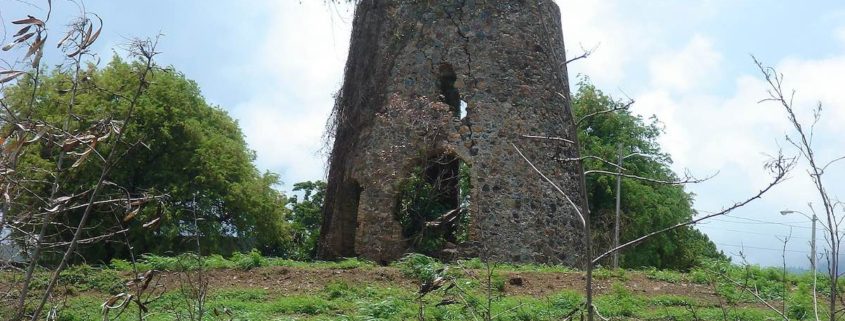
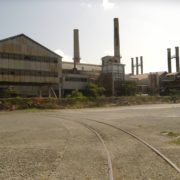


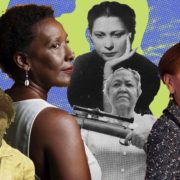
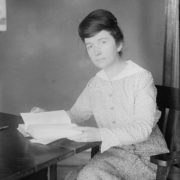
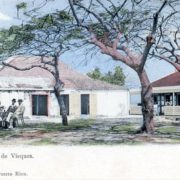
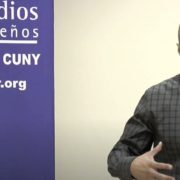
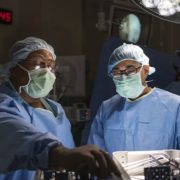


Leave a Reply
Want to join the discussion?Feel free to contribute!